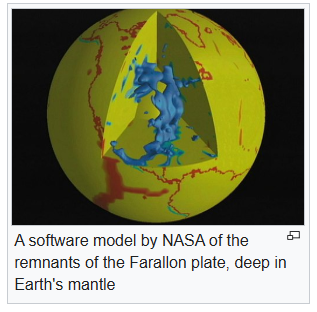New research
published in Nature Geoscience based on seismic full-waveform tomography
showing active cratonic thinning of the North American stable craton has been
found to be consistent with the phenomenon of lithospheric dripping. The
American Geophysical Union defines a craton as
“… a large, coherent domain of Earth's continental crust
that has attained and maintained long-term stability, having undergone little
internal deformation, except perhaps near its margins due to interaction with
neighbouring terranes.”
Cratons are tectonic plates that are the most stable away from their margins. Typically, they are very old Precambrian-aged granite-greenstone terrains. Once the density, composition, and thermal properties become stable, the crust is considered a craton. There are about 35 cratons identified around the world. The current study considers the craton known as the North American plate under which the Farallon plate began subducting around 180 million years ago.
Lithospheric dripping involves the interaction between the earth’s crust and the deeper mantle. It occurs when the underside of Earth's rocky crust is heated to a threshold temperature where it the underside of the crust starts to melt and eventually forms a “drip” that eventually breaks off and falls deeper into the planet. A 2D cross-section of the dripping under the North American craton is shown below.
The Farallon plate, a very
old oceanic plate, is almost entirely subducted under the North American plate.
The Farallon plate began as a mid-ocean ridge around 180 million years ago, the
basic time it takes for an oceanic plate to complete its cycle of subducting
under a continental plate, as I learned in geology classes.
According to Wikipedia,
seismic tomography can be used to image the subducted plate as long as it has
not achieved thermal equilibrium with the mantle.
“Seismic tomography can be used to image the remainder
of the subducted plate because it is still "cold," meaning that it
has not reached thermal equilibrium with the mantle. This is important for the
use of tomography because seismic waves have different velocities in materials
of different temperatures, so the Farallon slab appears as a velocity anomaly
on the tomography model.”
The dripping is causing
lithospheric thinning under the craton. The dripping is concentrated over the
U.S. Midwest. The following figures show the changes from millions of years ago
(at least 30, I can’t tell fully since Nature likes to make it so you can’t see
figures) compared to the present.
The abstract of the
paper, Seismic full-waveform tomography of active cratonic thinning
beneath North America consistent with slab-induced dripping, is shown
below.
Abstract
Continental cratons are characterized by thick lithospheric
roots that remain intact for billions of years. However, some cratonic roots
appear to have been thinned or completely removed in the geological past. The
mechanisms for thinning have been difficult to distinguish for these past
events. Here we present a full-waveform seismic tomographic model for North
America that allows the resolution of fine-scale structures and reveals an
extensive craton-thinning event that is ongoing. The seismic images show
extensive drip-like features that suggest the transport of lithospheric
materials from the base of the craton beneath the central United States to the
mantle transition zone, and thus active lithospheric thinning. Geodynamic
modelling suggests that the dripping may be mobilized by large-scale mantle
flow induced by the sinking of the Farallon slab that is currently in the lower
mantle. Dripping lithosphere could be further facilitated by prior lithospheric
weakening, for example by volatiles released from the slab. Our seismological
observations of active extensive thinning of cratonic lithosphere support
lithospheric removal could be a result of external mantle processes, which we
hypothesize may include the deep mantle effects of subduction.
Thorsten Becker, a professor at the University of
Texas at Austin’s Jackson School of Geosciences Department of Earth and
Planetary Sciences and Institute for Geophysics noted:
“This sort of thing is important if we want to
understand how a planet has evolved over a long time. It helps us understand
how do you make continents, how do you break them, and how do you recycle them
[into the Earth.]”
References:
Earth’s
Crust is Dripping Under Midwest US, Scientists Discover. Michelle Starr.
Science Alert. April 2, 2025. Earth's
Crust Is Dripping Under Midwest US, Scientists Discover
Seismic
full-waveform tomography of active cratonic thinning beneath North America
consistent with slab-induced dripping. Junlin Hua, Stephen P. Grand, Thorsten
W. Becker, Helen A. Janiszewski, Chujie Liu, Daniel T. Trugman & Hejun Zhu.
Nature Geoscience (2025). Seismic full-waveform
tomography of active cratonic thinning beneath North America consistent with
slab-induced dripping | Nature Geoscience
North
America is Dripping from Below, Geoscientists Discover. Texas Geosciences.
University of Texas at Austin. April 1, 2025. North
America is Dripping from Below, Geoscientists Discover | Jackson School of
Geosciences | The University of Texas at Austin
Farallon
plate. Wikipedia. Farallon
plate - Wikipedia
North
American plate. Wikipedia. North American plate
- Wikipedia
What
is a craton? How many are there? How do they relate? And how did they form? Bleeker,
W. ; Davis, B. W. American Geophysical Union, Spring Meeting, May 2004. What is a
craton? How many are there? How do they relate? And how did they form? -
Astrophysics Data System








No comments:
Post a Comment